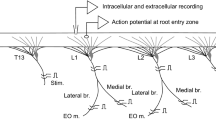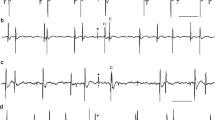Summary
Using intracellular recording techniques, we studied the response characteristics of two separate populations of triceps surae motoneurons in unanesthetized decerebrate cats, recorded before and after low thoracic hemisection of the spinal cord. In each preparation, we studied the response properties of one group of motoneurons and the protocol was then repeated for a separate group, immediately following the dorsal hemisection. In each group, we examined both the minimum firing rates of motoneurons during intracellular current injection and a range of cellular properties, including input resistance, rheobase current and afterhyperpolarization time course and magnitude. Although earlier studies from this laboratory have shown substantial reductions in minimum firing rate in reflexively active motoneurons in the hemisected decerebrated preparation, the response of motoneurons to intracellular current injection in the current preparation proved to be quite different. Minimum firing rates were either normal or even somewhat higher in the post-lesion group, while the time course of the afterhyperpolarization was shortened. Moreover, these effects were not evenly distributed across the motoneuron pool. The rate effect was most evident in motoneurons with higher conduction velocity, while the afterhyperpolarization effect occurred predominantly in motoneurons with lower conduction velocity. Neither of these effects could be accounted for by lesion-induced changes in other cellular properties. We conclude that tonically active neurons with descending axons traversing dorsolateral white matter may influence both the discharge characteristics and membrane properties of spinal motoneurons in novel ways, presumably by modifying voltage or calcium activated motoneuronal conductances. The previously described reactions in the the firing rate of motoneurons after such lesions appear to be mediated by different means, perhaps by alterations in synaptic input from segmental interneurons.
Similar content being viewed by others
References
Barrett EF, Barrett JN (1976) Separation of two voltage-sensitive potassium currents, and demonstration of a tetrodotoxin-resistant calcium current in frog motoneurones. J Physiol 255:737–774
Björklund A, Skagerberg G (1982) Descending monoaminergic projections to the spinal cord. In: Sjolund B, Björklund A (eds) Brain stem control of spinal mechanisms. Elsevier, Amsterdam, pp 55–88
Blaschak MJ, Powers RK, Rymer WZ (1988) Disturbances of motor output in a cat hindlimb muscle after acute dorsal spinal hemisection. Exp Brain Res 71:377–387
Burke D, Knowles L, Andrews C, Ashby P (1972) Spasticity, decerebrate rigidity and the clasp-knife phenomenon: an experimental study in the cat. Brain 95:31–48
Burke RE (1981) Motor units: anatomy, physiology and functional organization. In: Brooks VB (ed) Handbook of physiology, Section 1. The nervous system, Vol II. Motor control, Part 1. Am Physiol Soc, Bethesda, pp 345–422
Burke RE, Ten Bruggencate G (1971) Electrotonic characteristics of alpha motoneurones of varying size. J Physiol 212:1–20
Calvin WH (1974) Three modes of repetitive firing and the role of threshold time course between spikes. Brain Res 69:341–346
Calvin WH, Stevens CF (1968) Synaptic noise and other sources of randomness in motoneuron interspike intervals. J Neurophysiol 31:574–587
Clamann HP (1969) Statistical analysis of motor unit firing patterns in a human muscle. Biophys J 9:1233–1251
Conway BA, Hultborn H, Kiehn O, Mintz I (1988) Plateau potentials in alpha-motoneurones induced by intravenous injection of L-DOPA and clonidine in the spinal cat. J Physiol 405:369–384
Fung SJ, Barnes CD (1987) Coerulospinal enhancement of repetitive firing with correlative changes in postspike afterhyperpolarization of cat spinal motoneurons. Arch Ital Biol 125:171–186
Granit R, Kernell D, Shortess GK (1963) Quantitative aspects of repetitive firing of mammalian motoneurones, caused by injected currents. J Physiol 168:911–931
Granit R, Kernell D, Lamarre Y (1966) Algebraic summation in synaptic activation of motoneurons firing within the ‘primary range’ to injected currents. J Physiol 187:379–399
Haas HL, Konnerth A (1983) Histamine and noradrenaline decrease calcium-activated potassium conductance in hippocampal pyramidal cells. Nature 302:432–434
Hoefer P, Putnam T (1940) Action potentials of muscle in spastic conditions. Arch Neurol Psychiat 43:1–22
Horn JP, McAfee DA (1980) Alpha-adrenergic inhibition of calcium-dependent potentials in rat sympathetic neurones. J Physiol 301:191–204
Hounsgaard J, Hultborn H, Jespersen B, Kiehn O (1984) Intrinsic membrane properties causing a bistable behavior of alpha-motoneurones. Exp Brain Res 55:391–394
Hounsgaard J, Hultborn H, Jespersen B, Kiehn O (1988a) Bistability of alpha-motoneurones in the decerebrate cat and in the acute spinal cat after intravenous 5-hydroxytryptophan. J Physiol 405:345–367
Hounsgaard J, Kiehn O (1985) Ca++ dependent bistability induced by serotonin in spinal motoneurons. Exp Brain Res 57:422–425
Hounsgaard J, Kiehn O (1989) Serotonin-induced bistability of turtle motoneurones caused by a nifedipine-sensitive calcium plateau potential. J Physiol 414:265–282
Hounsgaard J, Kiehn O, Mintz I (1988b) Response properties of motoneurones in a slice preparation of the turtle spinal cord. J Physiol 398:575–589
Ito M, Oshima T (1965) Electrical behaviour of the motoneurone membrane during intracellularly applied current steps. J Physiol 180:607–635
Kernell D (1965) The limits of firing frequency in cat lumbosacral motoneurones possessing different time course of afterhyperpolarization. Acta Physiol Scand 65:87–100
Kernell D (1969) Synaptic conductance changes and the repetitive impulse discharge of spinal motoneurons. Brain Res 15:291–294
Kernell D (1985) Functional properties of spinal motoneurons and gradation of muscle force. In: Desmedt JE (ed) Motor control mechanisms in health and disease. Raven, New York, pp 213–226
Lundberg A (1982) Inhibitory control from the brain stem of transmission from primary afferents to motoneurons, primary afferent terminals and ascending pathways. In: Sjolund B, Björklund A (eds) Brain stem control of spinal mechanisms. Elsevier, Amsterdam, pp 179–224
Madison DV, Nicoll RA (1986) Actions of noradrenaline recorded intracellularly in rat hippocampal CAl pyramidal neurones, in vitro. J Physiol 372:221–244
McIntosh JE, McIntosh RP (1980) Mathematical modelling and computers in endocrinology. Monographs on endocrinology, Vol 16. Springer, New York, pp 250–260
Powers RK, Rymer WZ (1988) Effects of acute dorsal spinal hemisection on motoneuron discharge in the medial gastrocnemius of the decerebrate cat. J Neurophysiol 59:1540–1556
Rosenfalck A, Andreassen S (1980) Impaired regulation of force and firing pattern of single motor units in patients with spasticity. J Neurol Neurosurg Psychiat 43:907–916
Rymer WZ, Houk JC, Crago PE (1979) Mechanisms of the clasp-knife reflex studied in an animal model. Exp Brain Res 37:93–113
Schwindt PC, Calvin WH (1973) Equivalence of synaptic and injected current in determining the membrane potential trajectory during motoneuron rhythmic firing. Brain Res 59:389–394
Schwindt PC, Crill WE (1980a) Effects of barium on cat spinal motoneurons studied by voltage clamp. J Neurophysiol 44:827–846
Schwindt PC, Crill WE (1980b) Properties of a persistent inward current in normal and TEA-injected motoneurons. J Neurophysiol 43:1700–1724
Schwindt PC, Crill WE (1983) Membrane properties of cat spinal motoneurons. In: Davidoff RA (ed) Handbook of the spinal cord. Dekker, New York, pp 199–242
Tang A, Rymer WZ (1981) Abnormal force-emg relations in paretic limbs of hemiparetic human subjects. J Neurol Neurosurg Psychiat 44:690–698
Van Dongen PAM, Grillner S, Hökfelt T (1986) 5-Hydroxytryptamine (serotonin) causes a reduction in the afterhyperpolarization following the action potential in lamprey motoneurons and premotor interneurons. Brain Res 366:320–325
Walton K, Fulton BP (1986) Ionic mechanisms underlying the firing properties of rat neonatal motoneurons studied in vitro. Neurosci 19:669–683
White SR, Fung SJ (1989) Serotonin depolarizes cat spinal motoneurons in situ and decreases motoneuron afterhyperpolarizing potentials. Brain Res 502:205–213
Young R, Shahani B (1980) A clinical neurophysiological analysis of single motor unit discharge patterns in spasticity. In: Feldman RG, Young RR, Koella WP (eds) Spasticity: disordered motor control. Yearbook, Chicago, pp 219–231
Zengel JE, Reid SA, Sypert GW, Munson JB (1985) Membrane electrical properties and prediction of motor-unit type of medial gastrocnemius motoneurons in the cat. J Neurophysiol 53:1323–1344
Zhang L, Krnjevic K (1987) Apamin depresses selectively the after-hyperpolarization of cat spinal motoneurons. Neurosci Lett 74:58–62
Author information
Authors and Affiliations
Rights and permissions
About this article
Cite this article
Carp, J.S., Powers, R.K. & Rymer, W.Z. Alterations in motoneuron properties induced by acute dorsal spinal hemisection in the decerebrate cat. Exp Brain Res 83, 539–548 (1991). https://doi.org/10.1007/BF00229832
Received:
Accepted:
Issue Date:
DOI: https://doi.org/10.1007/BF00229832




